Are you ready to unlock the secrets of successful gardening? Dive into my treasure trove of little known gardening tips and discover the hidden techniques that will transform your green space into a flourishing paradise.
Key Takeaways:
- Keyhole gardening is a sustainable gardening method that originated in southern Africa
- Building a keyhole garden involves constructing an exterior wall, creating a tube in the center, and filling the garden area with compostable materials
- The Abundance Garden Course offers a high performance gardening system for growing nutrient-dense organic food
- The course covers topics such as soil biology, intensive raised beds, plant varieties, and garden planning
- Participants in The Abundance Garden Course have access to personal support and a community portal
Keyhole Gardening: A Sustainable Approach
One little known gardening technique that has gained popularity in recent years is keyhole gardening—a sustainable approach that can help you save water and create a thriving garden while using recycled materials. Originating in southern Africa, where resources are scarce and the climate is unforgiving, keyhole gardening is an unconventional method that has proven to be highly efficient.
The concept behind keyhole gardening involves building a raised bed in the shape of a circle with a slice cut away, creating a keyhole shape. This design allows for easy access to the center composting basket, which serves as the heart of the garden. Not only does keyhole gardening require less water than conventional gardening, but it also promotes efficient nutrient recycling by utilizing kitchen scraps and other compostable materials.
To build a keyhole garden, start by measuring a 6-foot diameter circle and constructing an exterior wall about 3 feet high using rocks, bricks, or other materials. Create a tube in the center with wire mesh, and line the outer walls with cardboard to add carbon, nitrogen, and air to the soil. Fill the garden area with layers of compostable materials, such as leaves, grass clippings, and shredded paper. In the center basket, alternate layers of compostable material and kitchen scraps. Water the garden sparingly, only when necessary, to encourage the plants’ roots to reach toward the center basket for moisture.
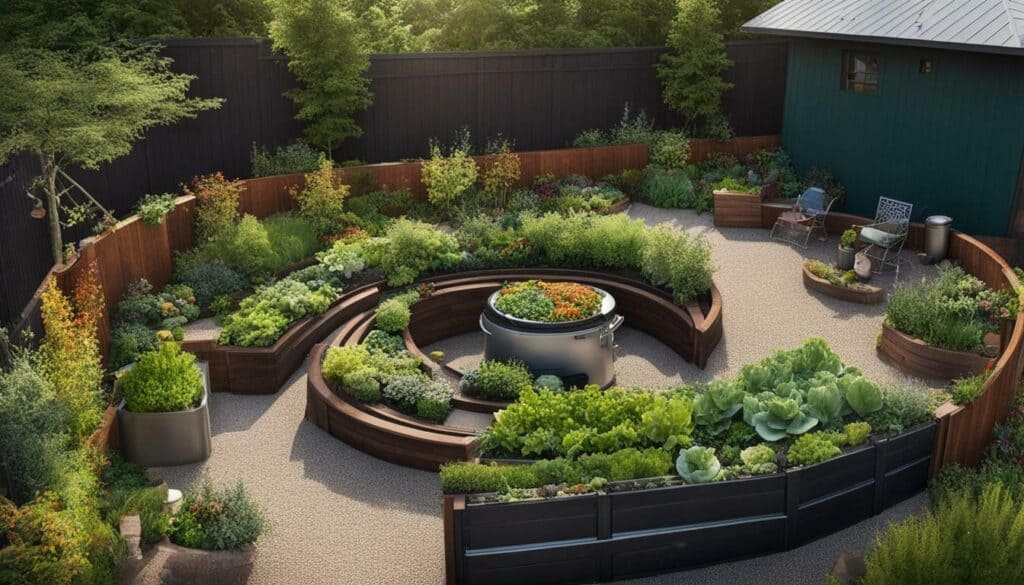
Unlocking the Secrets of Keyhole Gardening
Keyhole gardening is an insider’s secret to achieving a lush and abundant garden. By implementing this sustainable approach, you can save water, improve soil health, and grow a wide variety of plants even in a compact space. Whether you’re an experienced gardener looking to try something new or a beginner eager to unlock nature’s secrets, keyhole gardening is a technique worth exploring.
So why wait? Take a step towards creating a sustainable and thriving garden by embracing the little known technique of keyhole gardening. Discover the joy of growing your own food while contributing to a greener and more eco-friendly world.
| Benefits of Keyhole Gardening |
|---|
| Efficient water usage |
| Improved soil health |
| Variety of plants in a compact space |
Building a Keyhole Garden: Step-by-Step Guide
Ready to try your hand at keyhole gardening? Follow this step-by-step guide to build your very own keyhole garden and unlock the potential of this lesser-known gardening technique.
1. Measure and mark a 6-foot diameter circle in your desired garden location. This will serve as the outer boundary of your keyhole garden.
2. Construct an exterior wall around the marked circle, about 3 feet high. You can use rocks, stones, bricks, cinder blocks, or any other materials you prefer.
3. In the center of the garden, create a tube using wire mesh. This will serve as the composting basket, where you will add compostable materials and kitchen scraps.
4. Line the inner walls of the keyhole garden with cardboard. This will help retain moisture and improve soil health by adding carbon, nitrogen, and air to the soil.
5. Start filling the garden area with layers of compostable materials such as grass clippings, leaves, straw, and vegetable scraps. Aim for a height of around 2 feet.
6. Fill the center composting basket with alternating layers of compostable material and kitchen scraps. This will provide a steady supply of nutrients for your plants.
7. Water your keyhole garden sparingly, only when necessary, to encourage the plants’ roots to search for water deeper into the garden, towards the center composting basket.
Remember to choose plants that are suitable for your climate and gardening goals, and enjoy the process of watching your keyhole garden thrive.
Table: Materials for Building a Keyhole Garden
| Materials | Quantity |
|---|---|
| Exterior wall materials (e.g., rocks, stones, bricks) | Varies based on garden size |
| Wire mesh | 1 roll |
| Cardboard | Several sheets |
| Compostable materials (grass clippings, leaves, straw) | As needed to fill the garden area |
| Kitchen scraps | As needed to fill the center composting basket |
With this step-by-step guide and the right materials, you can easily construct a keyhole garden in your own backyard. Embrace this lesser-known gardening technique and unlock the potential of your green space.
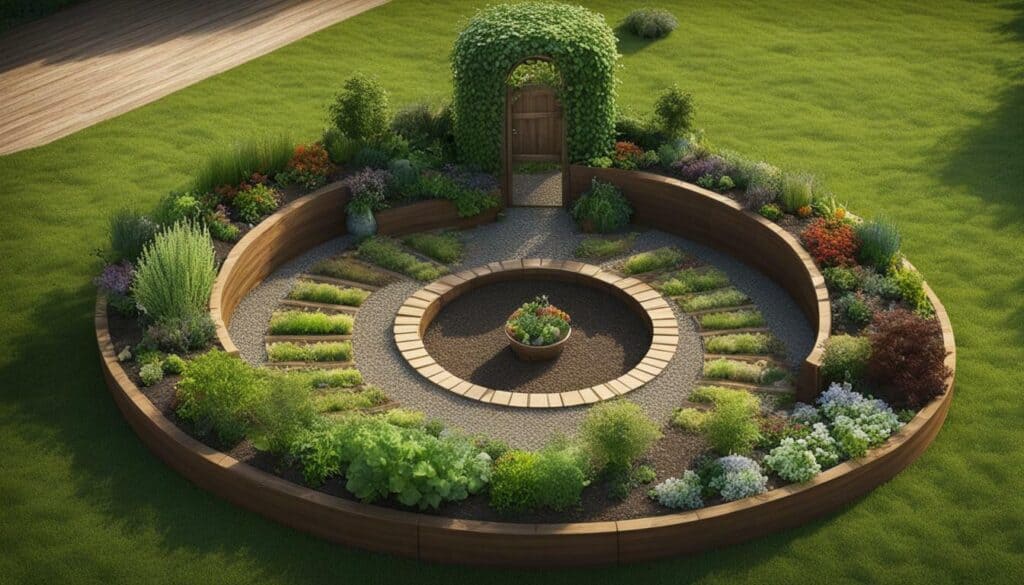
The Benefits of Keyhole Gardening
Keyhole gardening offers a range of benefits that can take your gardening experience to the next level. From conserving water to maximizing your plant yield, this unconventional gardening technique is a true game-changer.
One of the main advantages of keyhole gardening is its efficient water usage. The circular shape of the bed, with a slice cut away, allows for easy access to all plants from a central point. This design enables water to be distributed evenly, ensuring that every plant receives the moisture it needs. By watering only when necessary, you can conserve water and prevent wastage.
In addition to water conservation, keyhole gardening also promotes improved soil health. The composting basket placed in the center continuously supplies nutrients to the surrounding plants. As the compost breaks down, it enriches the soil, creating a fertile environment for your plants to thrive. This natural fertilization process reduces the need for synthetic fertilizers, making keyhole gardening an eco-friendly choice.
Furthermore, keyhole gardening allows you to grow a variety of plants in a compact space. The raised bed provides ample planting room, while the composting basket acts as a nutrient-rich hub for your plants. This means that even with limited space, you can cultivate a diverse range of fruits, vegetables, and herbs, maximizing your plant yield and enjoying a bountiful harvest.
Unlock the Full Potential of Your Garden
With keyhole gardening, you not only unlock nature’s secrets but also tap into the immense benefits it offers. By conserving water, improving soil health, and maximizing plant yield, this unconventional gardening technique allows you to create a thriving, abundant garden in any space.
| Benefits of Keyhole Gardening | Keyhole Gardening Techniques |
|---|---|
| Efficient water usage | Building a raised bed in a circular shape with a slice cut away |
| Improved soil health | Using a composting basket in the center to continuously supply nutrients |
| Maximizing plant yield | Growing a variety of plants in a compact space |
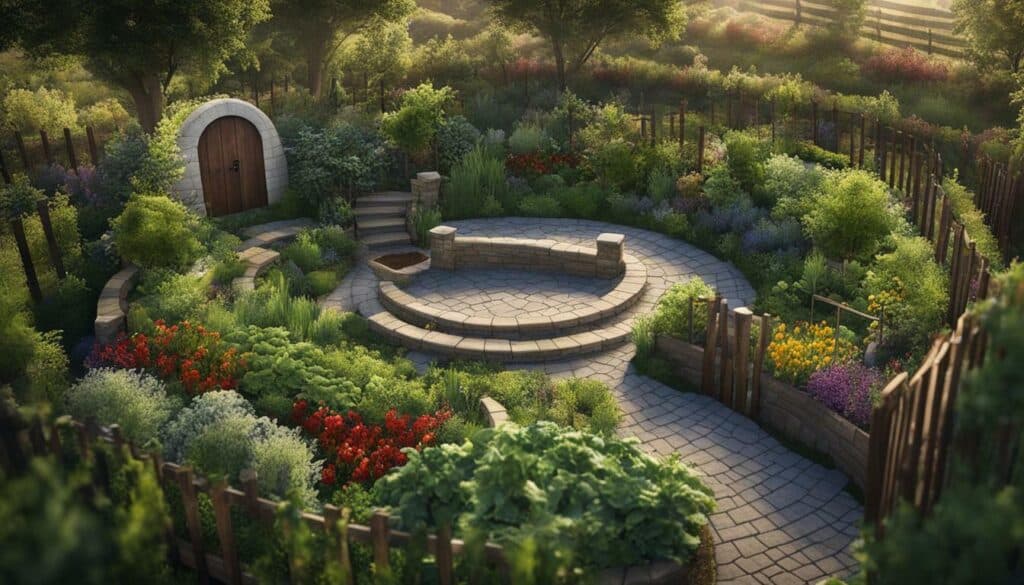
Incorporating keyhole gardening into your green space can transform your gardening experience. Unlocking the secrets of this sustainable method will not only benefit your plants but also contribute to a more environmentally conscious approach to gardening.
The Abundance Garden Course: Maximizing Your Harvest
Looking to take your gardening skills to new heights? The Abundance Garden Course is here to help you master the secrets of high performance gardening and maximize your harvest in a small space. This online course is designed to equip you with the expert gardening advice and insider tips you need to create an abundant garden, overflowing with nutrient-dense organic food.
With just 15 minutes a day and a compact garden space of 128 square feet, you can learn how to grow an abundance of fresh produce. The Abundance Garden Course covers a wide range of topics, from soil biology and intensive raised beds to plant varieties, planting schedules, and garden planning. You’ll also learn about essential tools and fertilizer, plant protection, watering techniques, and how to properly put your garden to bed for the season.
What sets The Abundance Garden Course apart is the personal support and community portal it offers. As you progress through the course, you’ll have access to expert guidance and advice, ensuring that you can confidently navigate any challenges that arise. You’ll also become part of a thriving community of like-minded gardeners, where you can share experiences, ask questions, and celebrate your gardening successes.
So why wait? Join The Abundance Garden Course today and unlock the secrets to high performance gardening. Get ready to enjoy a bountiful and thriving garden, filled with an abundance of fresh and nutritious produce.
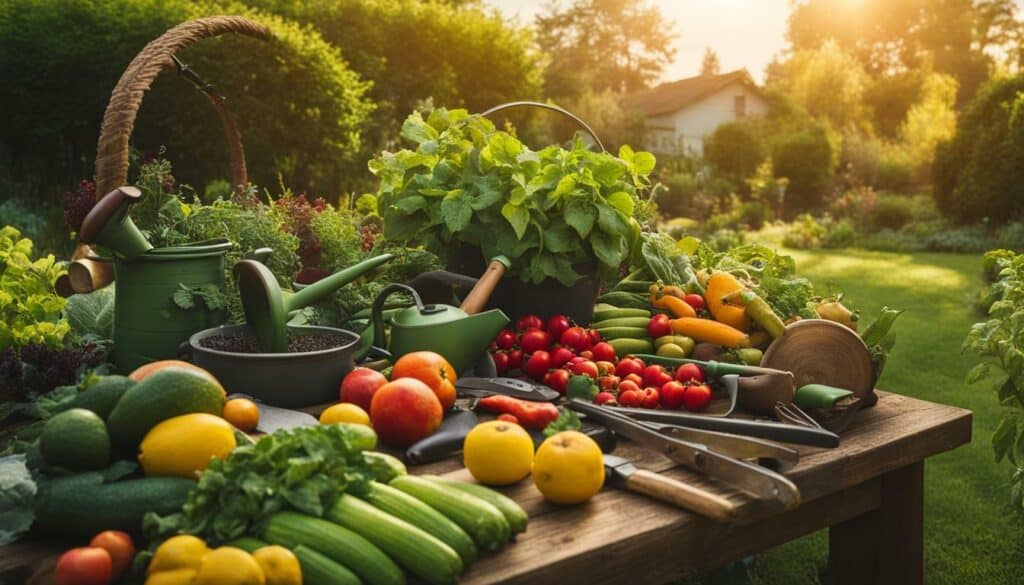
What You’ll Learn in The Abundance Garden Course
The Abundance Garden Course covers a wide range of essential gardening topics, ensuring you have the knowledge and skills to create a productive and thriving garden. Whether you’re a beginner looking to start your gardening journey or an experienced gardener seeking to refine your techniques, this course has something for everyone.
Here’s a sneak peek at some of the key topics covered in The Abundance Garden Course:
- Soil: Discover the importance of soil health and learn how to create and maintain nutrient-rich soil for optimal plant growth.
- Intensive Raised Beds: Explore the concept of raised beds and how to build and manage them effectively to maximize your garden’s productivity.
- Plant Varieties: Learn about different types of plants, their specific needs, and how to choose the right varieties for your garden.
- Garden Planning: Master the art of garden planning, including crop rotation, companion planting, and maximizing space utilization.
Tools and Fertilizer
Discover the essential tools and equipment needed for successful gardening, as well as the different types of fertilizers and how to use them responsibly to promote plant growth without harming the environment.
Throughout the course, you’ll benefit from detailed video tutorials, interactive exercises, and downloadable resources to enhance your learning experience. You’ll also gain access to personal support from gardening experts who can answer your questions and provide tailored advice for your specific gardening needs.

The Abundance Garden Course is designed to empower you with the knowledge and confidence to create a bountiful garden that will provide you with a sustainable source of fresh, organic food. Whether you have a small balcony or a spacious backyard, this course will teach you the insider tips and secret techniques to unlock your garden’s full potential. Enroll today and embark on your journey to gardening success!
Personal Support and Community Portal
When you enroll in The Abundance Garden Course, you gain access to a wealth of support and resources, including personal guidance from gardening experts and a vibrant community of fellow garden enthusiasts. Whether you’re a beginner or an experienced gardener, having access to expert gardening tips and insider gardening advice can greatly enhance your gardening experience.
With personal support, you can receive one-on-one guidance tailored to your specific gardening needs. You’ll have the opportunity to ask questions, seek advice, and troubleshoot any challenges you may encounter along the way. This personalized attention can help you overcome obstacles and maximize the success of your garden.
In addition to personal support, The Abundance Garden Course provides access to a community portal where you can connect with like-minded individuals who share your passion for gardening. This online community is a hub of knowledge, where you can exchange ideas, share success stories, and learn from others’ experiences. By being part of this vibrant community, you’ll have a network of fellow gardeners who can offer valuable insights and inspiration.
Unlock the Secrets of Successful Gardening
With expert gardening tips, insider gardening advice, and gardening hacks at your fingertips, you’ll have the tools and knowledge needed to take your gardening skills to the next level. The personal support and community portal offered through The Abundance Garden Course ensure that you’re never alone on your gardening journey.
So why wait? Join The Abundance Garden Course today and unlock nature’s secrets to create a thriving and bountiful garden in your own backyard.
| Benefits of Personal Support and Community Portal |
|---|
| Access to gardening experts for personalized guidance |
| Opportunity to ask questions and troubleshoot challenges |
| Connect with a community of passionate gardeners |
| Exchange ideas, share success stories, and learn from others |
Putting It All Together: Your Garden Success
By incorporating these little known gardening tips into your gardening routine, you’ll be well on your way to creating a thriving garden that brings you joy and an abundance of fresh produce. Keyhole gardening, with its sustainable approach, is a game-changer for any green space. It originated in southern Africa, where resources are scarce and the climate is unforgiving, making it a perfect solution for water-wise gardening.
Building a keyhole garden is a simple and rewarding process. Start by measuring a 6-foot diameter circle and constructing an exterior wall about 3 feet high with rocks or other materials. Create a tube in the center with wire mesh and line the outer walls with cardboard. Fill the garden area with layers of compostable materials, such as kitchen scraps, grass clippings, leaves, and even cardboard. The center basket is a composting hotspot, where you can add alternating layers of compostable materials and kitchen scraps. This unique design not only saves water but also creates nutrient-rich soil that promotes healthy plant growth.
“The Abundance Garden Course takes gardening to the next level, offering expert guidance and insider tips on how to maximize your harvest. With just 15 minutes a day and 128 square feet, you can produce an abundance of nutrient-dense organic food,” says gardening enthusiast and course participant, Sarah Thompson.
The Abundance Garden Course is your gateway to becoming a gardening expert. This online course covers a wide range of topics, including soil biology, intensive raised beds, plant varieties, planting schedules, garden planning, tools and fertilizer, plant protection, and watering techniques. You’ll learn how to create an efficient and productive garden that takes advantage of every square inch of available space. Plus, you’ll have access to personal support from experienced gardeners and a community portal where you can connect with fellow gardeners, exchange ideas, and share your success stories.
With these little known gardening tips and the guidance provided by The Abundance Garden Course, you’ll be equipped with the knowledge and tools necessary to transform your garden into a thriving oasis. So, get ready to unlock nature’s secrets and enjoy the satisfaction of growing your own fresh and delicious produce.
| Tips for Successful Gardening |
|---|
| Use compostable materials in your keyhole garden to enrich the soil naturally. |
| Water your garden sparingly, focusing on the center basket to encourage deep root growth. |
| Try companion planting to maximize space and deter pests naturally. |
| Regularly monitor your garden for signs of pests or diseases and take appropriate measures to prevent their spread. |
Conclusion
Now that you’re armed with these little known gardening tips, it’s time to roll up your sleeves, get your hands dirty, and watch your garden thrive like never before.
Keyhole gardening is a sustainable gardening method that originated in southern Africa, where resources are scarce and the climate is unforgiving. By constructing a raised bed in the shape of a circle with a slice cut away, you can create a keyhole garden that requires less water than conventional gardening. Utilizing recycled materials and adding layers of compostable materials, such as cardboard, can further enhance the health and productivity of your garden.
If you’re ready to take on the challenge of building your own keyhole garden, it’s important to follow the step-by-step guide provided earlier. This includes measuring the dimensions, constructing the exterior wall, creating the composting basket, and filling the garden area with the right materials. Watering your garden only when necessary will encourage the plants’ roots to grow towards the center basket, optimizing their access to nutrients and moisture.
For those who are looking to dive even deeper into the world of high-performance gardening, The Abundance Garden Course offers a comprehensive online learning experience. By dedicating just 15 minutes a day and utilizing a compact garden space, you can learn how to grow nutrient-dense organic food. The course covers various topics, including soil biology, intensive raised beds, plant varieties, planting schedules, and garden planning. Plus, you’ll have access to personal support and a community portal, providing additional resources and guidance along your gardening journey.
What Are Some Beginner-Friendly Gardening Tips for Using Garden Edging?
Using garden edging can enhance the look of your garden and make it easier to maintain. For beginners, here’s a simple beginner’s guide to garden edging: Start by choosing the right material, such as bricks or plastic. Decide on the layout, keeping in mind the shape of your flower beds. Install the edging by digging a trench and placing the materials securely. Finally, maintain the neatness by regularly trimming the grass and weeds near the edging.
FAQ
Q: What is keyhole gardening?
A: Keyhole gardening is a sustainable gardening method that involves building a raised bed in the shape of a circle with a slice cut away, and a composting basket in the center. It requires less water than conventional gardening and can be built using recycled materials.
Q: How do I build a keyhole garden?
A: To build a keyhole garden, measure a 6-foot diameter circle, construct an exterior wall about 3 feet high using rocks or other materials, create a tube in the center with wire mesh, line the outer walls with cardboard, fill the garden area with layers of compostable materials, and fill the center basket with alternating layers of compostable material and kitchen scraps.
Q: What are the benefits of keyhole gardening?
A: Keyhole gardening has several benefits, including efficient water usage, improved soil health, and the ability to grow a variety of plants in a compact space.
Q: What is The Abundance Garden Course?
A: The Abundance Garden Course is an online course that teaches a high-performance gardening system, allowing anyone to grow nutrient-dense organic food in a compact garden. It only takes 15 minutes a day and 128 square feet to produce an abundance of food.
Q: What will I learn in The Abundance Garden Course?
A: In The Abundance Garden Course, you will learn about soil, soil biology, intensive raised beds, plant varieties, planting schedules, garden planning, tools and fertilizer, plant protection, watering, and putting the garden to bed.
Q: What additional support is available through The Abundance Garden Course?
A: Participants in The Abundance Garden Course have access to personal support and a community portal, providing additional assistance and resources for their gardening journey.

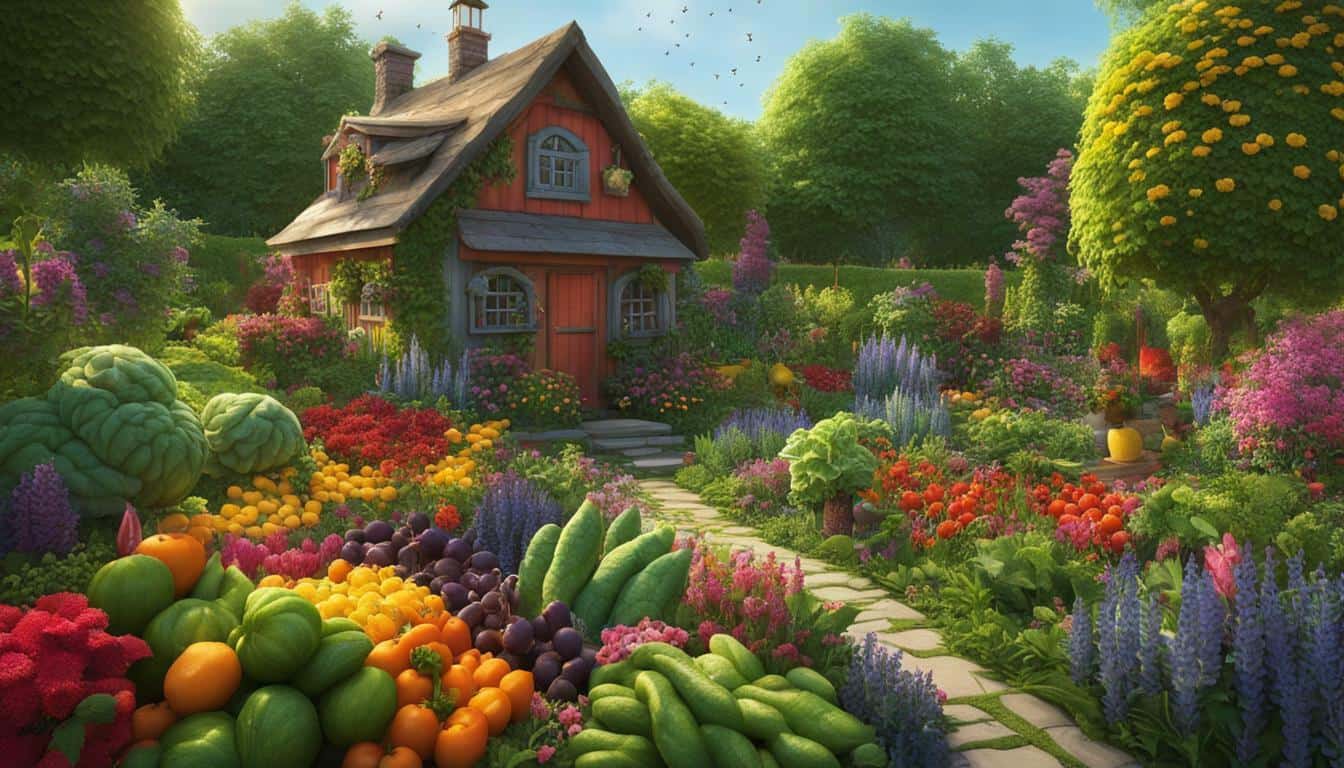



Leave a Reply